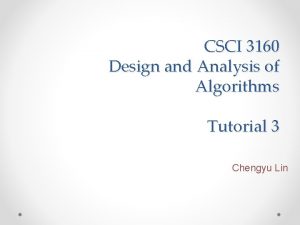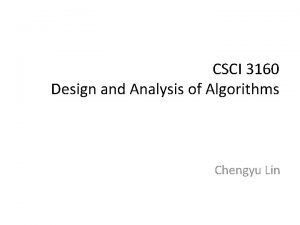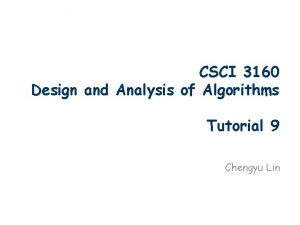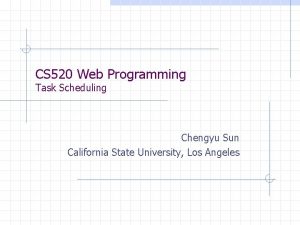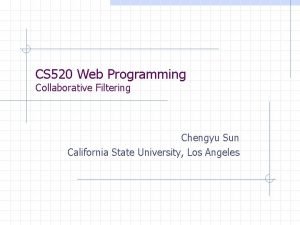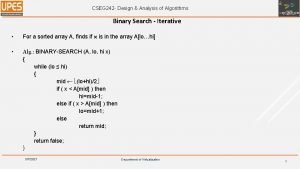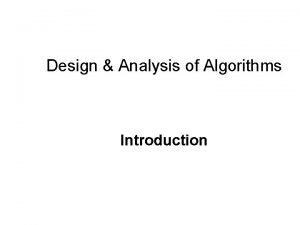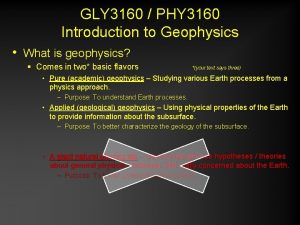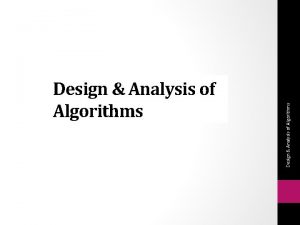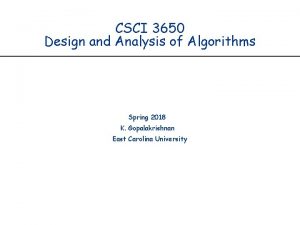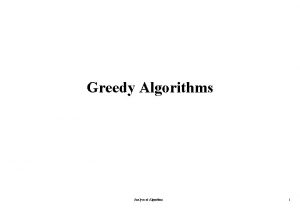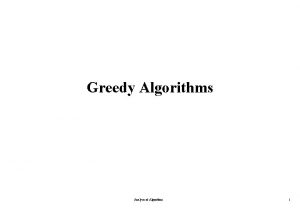CSCI 3160 Design and Analysis of Algorithms Chengyu












- Slides: 12

CSCI 3160 Design and Analysis of Algorithms Chengyu Lin

Approximation algorithms • Motivation – Some (optimization) problems are very hard – Unlikely to have efficient polynomial-time algorithms • Approximation algorithms – Algorithms to find approximate solutions to optimization problems.

Optimization • Many problems are actually optimization problems • i. e – the task can be naturally rephrased as finding a maximal/minimal solution • For example: Vertex Cover problem

Approximation Algorithm • An algorithm that returns near-optimal solutions in polynomial time • Approximation Ratio ρ(n): – Define: C* as a optimal solution and C is the solution produced by the approximation algorithm – max (C/C*, C*/C) <= ρ(n) – Maximization problem: 0 < C <= C*, thus C*/C shows that C* is larger than C by ρ(n) – Minimization problem: 0 < C* <= C, thus C/C* shows that C is larger than C* by ρ(n)

Techniques • A variety of techniques to design and analyze many approximation algorithms for computationally hard problems: – Combinatorial algorithms – Linear Programming based algorithms – Semi-definite Programming based algorithms

Vertex Cover •

Vertex Cover Problem • Definition: – Given an undirected graph G=(V, E), find a vertex cover with minimum size (has the least number of vertices) – This is sometimes called cardinality vertex cover • More generalization: – Given an undirected graph G=(V, E), and a cost function on vertices c: V → Q+ – Find a minimum cost vertex cover

How to solve it • Matching: – A set M of edges in a graph G is called a matching of G if no two edges in set M have an endpoint in common • Example:

How to solve it(cont. ) • Maximum Matching: – A matching of G with the greatest number of edges • Maximal Matching: – A matching which is not contained in any larger matching • Note: Any maximum matching is certainly maximal, but not the reverse

Main observation • No vertex can cover two edges of a matching • The size of every vertex cover is at least the size of every matching: |M| ≤ |C| • |M| = |C| indicates the optimality • Possible Solution: Using Maximal matching to find Minimum vertex cover

An Algorithm •

End • Questions?
 Csci 3160
Csci 3160 Csci 3160
Csci 3160 Csci 3160
Csci 3160 Hdfi
Hdfi Chengyu sun
Chengyu sun Chengyu sun
Chengyu sun Chengyu sun
Chengyu sun Design and analysis of algorithms syllabus
Design and analysis of algorithms syllabus Design and analysis of algorithms introduction
Design and analysis of algorithms introduction Binary search in design and analysis of algorithms
Binary search in design and analysis of algorithms Introduction to the design and analysis of algorithms
Introduction to the design and analysis of algorithms Design and analysis of algorithms
Design and analysis of algorithms Design and analysis of algorithms
Design and analysis of algorithms
